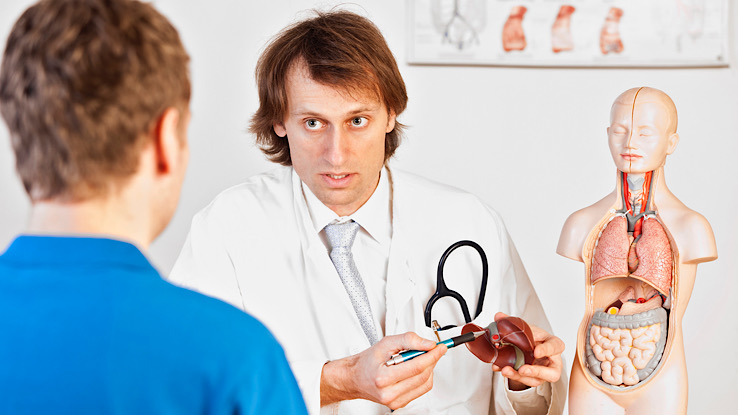Clean Your Liver the Easy Way When Working

Your liver is an important organ responsible for digesting food, storing energy, and helping remove poisons from your body. Like many other organs in your body, your liver can also develop diseases that can interfere with its normal function and impact your overall health. Diagnosing liver disease as early as possible is important to improve your treatment outcomes. Understanding what liver disease is and some of its symptoms can empower you to take charge of your health and begin getting the care you need.
Liver disease (also known as hepatic disease) is a type of damage to or disease of the liver. Many different things can damage and interrupt the normal functioning of your liver, and these illnesses, behaviors, and other conditions eventually lead to liver disease.
Types of liver disease can be divided into several different categories.
Genetic liver diseases
Genetic liver diseases are conditions that run in your family and are passed down through genes. Such diseases prevent your liver from filtering harmful substances out of your blood properly, leading to excess things like iron (Hemochromatosis) or copper (Wilson's disease) in your system.
Autoimmune liver disease
In some cases, autoimmune conditions can lead to liver damage. When you have an autoimmune disease, it means your immune system mistakenly attacks healthy cells instead of the harmful cells that it's supposed to eliminate from your body. Some autoimmune disorders like primary biliary cholangitis cause long-term inflammation in your liver which can lead to other types of damage.
Liver disease caused by infections
Liver disease caused by infections typically result from viruses, parasites, or other pathogens transmitted to you from another person or source (such as Hepatitis A, B, and C). Infections frequently lead to the death of liver cells and to inflammation, which can turn into fibrosis and cirrhosis if left untreated.
Alcohol-related liver disease (ARLD)
Chronic misuse of alcohol can cause of liver damage. Drinking alcohol excessively over a period of years often leads to inflammation and eventually cirrhosis because it kills off liver cells. It can also increase your risk of developing liver cancer.
Non-alcoholic fatty liver disease (NAFLD)
NAFLD is caused by a build-up of fat in the liver, usually in people who are overweight or obese. This type of liver disease is increasingly common, particularly in Western countries.
Liver cancer
Liver cancer begins when the cells of your liver start to change and grow out of control. This is sometimes caused by existing liver diseases but can also occur in people with no existing conditions. The cause is unknown.
What Are the Symptoms of Liver Disease?
Liver disease often does not cause any noticeable signs and symptoms in the early stages. As damage to the liver progresses, the symptoms may differ depending on the underlying cause of the disease. In general, the symptoms below indicate that there is some type of problem with your liver.
Changes in your physical appearance:
- Skin and eyes that look yellow (jaundice)
- Swelling in your stomach, legs, or ankles
- Bruising and bleeding more easily than usual
Changes in how you feel:
- Pain or discomfort in your stomach
- Extremely tired and weak (chronic fatigue)
- Being unwell or being sick
- Loss of appetite
- Unusually itchy skin
Changes when you go to the bathroom:
- Dark-colored urine
- Pale or clay-colored stool
What Is End-Stage Liver Disease?
Like other diseases, liver disease progresses through different stages of severity as it develops. In a healthy liver, when mild damage is sustained, the liver can often regenerate healthy tissue on its own. However, as the liver sustains more or prolonged damage (like excessive alcohol consumption), the organ may swell and become tender (inflammation).
Without treatment, this state of inflammation can cause continued liver damage when scar tissue forms on the organ and prevents normal blood flow to the rest of the body. Over time, the scars on your liver can harden, causing cirrhosis. Without treatment, cirrhosis can lead to complications, including liver cancer, end-stage liver disease, or chronic liver failure. Often the only treatment for end-stage liver disease is a liver transplant.
Identifying and getting treatment for liver disease as soon as possible is essential to avoid severe complications. You should consult your doctor if you experience any or a combination of the above symptoms.
Medical content reviewed by Briony Jain, PhD in Public Health
Resource Links:
- "End-stage Liver Disease (ESLD)" via UCSF Department of Surgery
- "Liver Disease" via Mayo Clinic
- "Liver Disease" via NHS
- "Cirrhosis of the Liver" via Cleveland Clinic
- "Common Characteristics of Liver Disease" via Johns Hopkins Medicine
Source: https://www.symptomfind.com/healthy-living/symptoms-liver-disease?utm_content=params%3Ao%3D740013%26ad%3DdirN%26qo%3DserpIndex&ueid=caea68bc-a4b2-477c-b3fd-f1e6c496fc6a